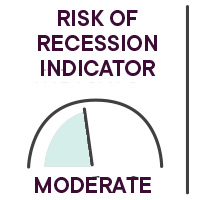Yann Furic
B.B.A., M. Sc., CFA®
Senior Portfolio Manager, Asset Allocation and Alternative Strategies
Interest rates continue to rise sharply
As in February, sharp rises in long-term interest rates occurred in March around the world. Such increases negatively impact the value of growth stocks, which significantly limits their performance.
Equity indices that are more heavily weighted in cyclical stocks (industrial products, financials, base metals and energy) benefited from the optimistic outlook for a strong economic recovery. Year to date, the Canadian S&P/TSX Index has climbed 8.1%, while the Nasdaq has gained 1.4% in Canadian dollars.
In the United States, thanks to accelerated vaccination campaigns, the country is expected to be one of the first to achieve herd immunity, which would enable it to run its economy at full capacity again. Elsewhere in the world, the availability of vaccines and the speed of vaccination campaigns will define the return to normal. This could result in a desynchronized global economic recovery and create some problems, although strong growth is expected in many sectors. Difficulties in international tourism will likely persist.
Focus on the past month

Overview of global equity markets*
- The flagship index of the Canadian stock market, the S&P/TSX, advanced 3.9% in February.
- In the United States, the S&P 500 gained 3.24% and the Nasdaq lost 0.6%.
- International stock markets were also in positive territory during the month, with the EAFE index up 1.7%.
- Emerging market equities fell 2.6% in March, while Chinese stocks were off 7.3%.
* All the percentages in this section are in Canadian dollars. Bloomberg unless otherwise indicated.
Key events
Employment situation
The United States continues to stand out with better-than-forecast job creation. 916,000 jobs were created, versus expectations of 660,000, and the jobless rate fell from 6.2% to 6.0%.
In Canada, 303,100 jobs were created, when expectations were for only 100,000. The unemployment rate was 7.5%, while the labour force participation rate rose to 65.2%, up from the previous month’s rate of 64.7%. In the coming weeks, the return of stricter lockdown measures in Ontario could lead to job losses in April.
Results – Canadian bonds
Government of Canada bonds across maturities posted a negative return of 0.5% for the month, still weighed down by rising interest rates. (Source: Canaccord Genuity)

Our strategic monitoring
Main risks
Here are some risks we are closely monitoring in the current environment.
- The cyclical recovery could be limited or delayed by the various problems affecting vaccine production and the occurrence of different variants.
- A sharp, rapid rise in interest rates would lower the price/earnings ratio, which would cause stock indices to fall.
- Governments could significantly increase corporate and personal tax rates to replenish their coffers. However, this scenario is unlikely in 2021.
- Inflation could rise sharply without economic growth, which would trigger an episode of stagflation.
Fundamental indicators
Some economic indicators that we continued to monitor in February.
Consumer confidence ![]()
The consumer confidence index topped 100 in March, for the first time since October. Vaccination campaigns have probably restored consumer confidence, especially in terms of job creation.
U.S. personal savings ![]()
The new $1.9 trillion stimulus package has been approved. The additional aid will increase personal savings, which already came to around $1.5 trillion at the end of 2020. This money is expected to be reinvested in the U.S. economy during the second half of 2021, as life gradually returns to normal.
Global Purchasing Managers’ Index ![]()
The index is now at 55, up from last month. A reading above 50 indicates an increase in purchasing managers’ intentions. Most countries are seeing higher purchasing intentions in the manufacturing sector. This situation, combined with low inventories, bodes well for the economy.
Benchmark rates in Canada, Europe and the United States ![]()
Rates remain at low levels, which is favourable for an economic recovery. This situation should continue until their economies return to a satisfactory rate of growth and a low unemployment rate, even if it means letting inflation exceed the targets set before tightening monetary policies.
François Landry
CFA®
Vice-President and Chief Investment Officer
Vice-Chairman of the Board of Directors of Professionals' Financial - Private Management
Our strategies
(6-to-12 month horizon)
The desynchronized reopening of global economies should help cyclical stocks that benefit from the recovery as well as small caps and, to some extent, emerging markets. In Canada, the S&P/TSX and small cap indices have a higher weighting of cyclical stocks such as financials, basic materials, industrial products and energy. As for technology stocks, they should continue to benefit from the structural changes accelerated by the pandemic.
The strategic target of the FDP Tactical Asset Allocation Private Portfolio is 65% equities and 35% bonds. In light of recent market movements, the equity weighting was increased to 70% and the bond weighting reduced to 30%.
The geographic allocation of equities in our portfolios remained the same. The equity weighting is neutral with no regional deviation, since the expected return is roughly the same in all cases. However, sector or factor positioning varies from one region to the next.
- In terms of Canadian equities, we have a favourable bias towards banks, which we increased in February.
- As for U.S. equities, we maintained our exposure to technology stocks and industrial products, which should benefit from announced infrastructure spending and the global economic recovery. Since the start of the year, we also initiated a small cap position and increased our exposure to cyclical issues.
- As far as EAFE (Europe, Australasia, Far East) equities are concerned, we maintained our neutral position due to the fiscal measures introduced in Europe and the partial lockdown in euro zone economies. The growing possibility of a third wave of the pandemic and hesitancy about the AstraZeneca vaccine over disclosures of possible side-effects could potentially delay the reopening of the euro zone.
François Landry, CFA
Vice-President and Chief Investment Officer
Yann Furic, B.B.A., M. Sc., CFA
Senior Portfolio Manager, Asset Allocation and Alternative Strategies
Sources: Bloomberg
The opinions expressed here and on the next page do not necessarily represent the views of Professionals’ Financial. The information contained herein has been obtained from sources deemed reliable, but we do not guarantee the accuracy of this information, and it may be incomplete. The opinions expressed are based upon our analysis and interpretation of this information and are not to be construed as a recommendation. Please consult your Wealth Management Advisor.










